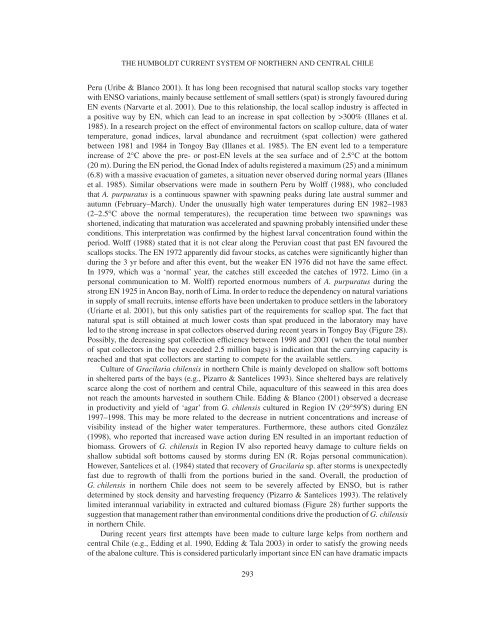the humboldt current system of northern and central chile - figema
the humboldt current system of northern and central chile - figema
the humboldt current system of northern and central chile - figema
Create successful ePaper yourself
Turn your PDF publications into a flip-book with our unique Google optimized e-Paper software.
THE HUMBOLDT CURRENT SYSTEM OF NORTHERN AND CENTRAL CHILEPeru (Uribe & Blanco 2001). It has long been recognised that natural scallop stocks vary toge<strong>the</strong>rwith ENSO variations, mainly because settlement <strong>of</strong> small settlers (spat) is strongly favoured duringEN events (Narvarte et al. 2001). Due to this relationship, <strong>the</strong> local scallop industry is affected ina positive way by EN, which can lead to an increase in spat collection by >300% (Illanes et al.1985). In a research project on <strong>the</strong> effect <strong>of</strong> environmental factors on scallop culture, data <strong>of</strong> watertemperature, gonad indices, larval abundance <strong>and</strong> recruitment (spat collection) were ga<strong>the</strong>redbetween 1981 <strong>and</strong> 1984 in Tongoy Bay (Illanes et al. 1985). The EN event led to a temperatureincrease <strong>of</strong> 2°C above <strong>the</strong> pre- or post-EN levels at <strong>the</strong> sea surface <strong>and</strong> <strong>of</strong> 2.5°C at <strong>the</strong> bottom(20 m). During <strong>the</strong> EN period, <strong>the</strong> Gonad Index <strong>of</strong> adults registered a maximum (25) <strong>and</strong> a minimum(6.8) with a massive evacuation <strong>of</strong> gametes, a situation never observed during normal years (Illaneset al. 1985). Similar observations were made in sou<strong>the</strong>rn Peru by Wolff (1988), who concludedthat A. purpuratus is a continuous spawner with spawning peaks during late austral summer <strong>and</strong>autumn (February–March). Under <strong>the</strong> unusually high water temperatures during EN 1982–1983(2–2.5°C above <strong>the</strong> normal temperatures), <strong>the</strong> recuperation time between two spawnings wasshortened, indicating that maturation was accelerated <strong>and</strong> spawning probably intensified under <strong>the</strong>seconditions. This interpretation was confirmed by <strong>the</strong> highest larval concentration found within <strong>the</strong>period. Wolff (1988) stated that it is not clear along <strong>the</strong> Peruvian coast that past EN favoured <strong>the</strong>scallops stocks. The EN 1972 apparently did favour stocks, as catches were significantly higher th<strong>and</strong>uring <strong>the</strong> 3 yr before <strong>and</strong> after this event, but <strong>the</strong> weaker EN 1976 did not have <strong>the</strong> same effect.In 1979, which was a ‘normal’ year, <strong>the</strong> catches still exceeded <strong>the</strong> catches <strong>of</strong> 1972. Limo (in apersonal communication to M. Wolff) reported enormous numbers <strong>of</strong> A. purpuratus during <strong>the</strong>strong EN 1925 in Ancon Bay, north <strong>of</strong> Lima. In order to reduce <strong>the</strong> dependency on natural variationsin supply <strong>of</strong> small recruits, intense efforts have been undertaken to produce settlers in <strong>the</strong> laboratory(Uriarte et al. 2001), but this only satisfies part <strong>of</strong> <strong>the</strong> requirements for scallop spat. The fact thatnatural spat is still obtained at much lower costs than spat produced in <strong>the</strong> laboratory may haveled to <strong>the</strong> strong increase in spat collectors observed during recent years in Tongoy Bay (Figure 28).Possibly, <strong>the</strong> decreasing spat collection efficiency between 1998 <strong>and</strong> 2001 (when <strong>the</strong> total number<strong>of</strong> spat collectors in <strong>the</strong> bay exceeded 2.5 million bags) is indication that <strong>the</strong> carrying capacity isreached <strong>and</strong> that spat collectors are starting to compete for <strong>the</strong> available settlers.Culture <strong>of</strong> Gracilaria <strong>chile</strong>nsis in nor<strong>the</strong>rn Chile is mainly developed on shallow s<strong>of</strong>t bottomsin sheltered parts <strong>of</strong> <strong>the</strong> bays (e.g., Pizarro & Santelices 1993). Since sheltered bays are relativelyscarce along <strong>the</strong> cost <strong>of</strong> nor<strong>the</strong>rn <strong>and</strong> <strong>central</strong> Chile, aquaculture <strong>of</strong> this seaweed in this area doesnot reach <strong>the</strong> amounts harvested in sou<strong>the</strong>rn Chile. Edding & Blanco (2001) observed a decreasein productivity <strong>and</strong> yield <strong>of</strong> ‘agar’ from G. <strong>chile</strong>nsis cultured in Region IV (29°59′S) during EN1997–1998. This may be more related to <strong>the</strong> decrease in nutrient concentrations <strong>and</strong> increase <strong>of</strong>visibility instead <strong>of</strong> <strong>the</strong> higher water temperatures. Fur<strong>the</strong>rmore, <strong>the</strong>se authors cited González(1998), who reported that increased wave action during EN resulted in an important reduction <strong>of</strong>biomass. Growers <strong>of</strong> G. <strong>chile</strong>nsis in Region IV also reported heavy damage to culture fields onshallow subtidal s<strong>of</strong>t bottoms caused by storms during EN (R. Rojas personal communication).However, Santelices et al. (1984) stated that recovery <strong>of</strong> Gracilaria sp. after storms is unexpectedlyfast due to regrowth <strong>of</strong> thalli from <strong>the</strong> portions buried in <strong>the</strong> s<strong>and</strong>. Overall, <strong>the</strong> production <strong>of</strong>G. <strong>chile</strong>nsis in nor<strong>the</strong>rn Chile does not seem to be severely affected by ENSO, but is ra<strong>the</strong>rdetermined by stock density <strong>and</strong> harvesting frequency (Pizarro & Santelices 1993). The relativelylimited interannual variability in extracted <strong>and</strong> cultured biomass (Figure 28) fur<strong>the</strong>r supports <strong>the</strong>suggestion that management ra<strong>the</strong>r than environmental conditions drive <strong>the</strong> production <strong>of</strong> G. <strong>chile</strong>nsisin nor<strong>the</strong>rn Chile.During recent years first attempts have been made to culture large kelps from nor<strong>the</strong>rn <strong>and</strong><strong>central</strong> Chile (e.g., Edding et al. 1990, Edding & Tala 2003) in order to satisfy <strong>the</strong> growing needs<strong>of</strong> <strong>the</strong> abalone culture. This is considered particularly important since EN can have dramatic impacts293










